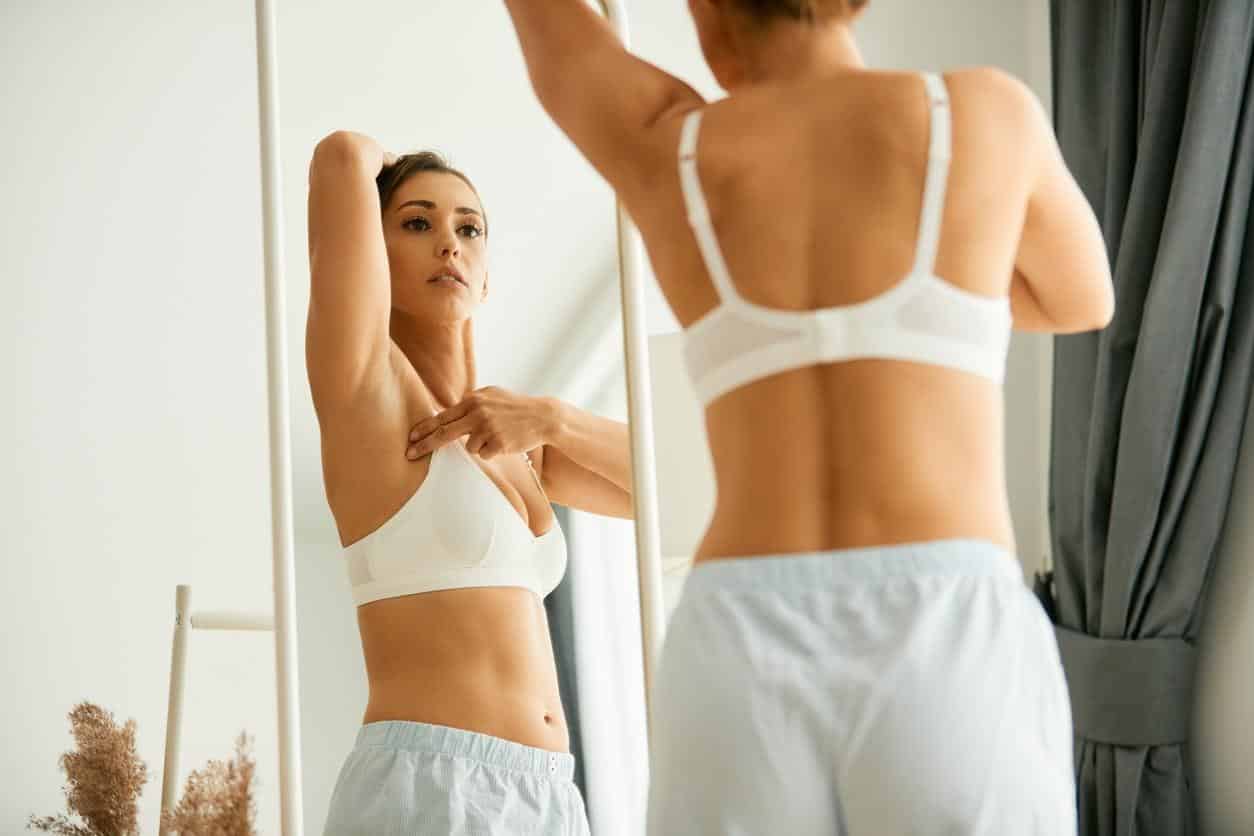One in every eight American women has a chance of developing breast cancer in her life, according to a report by the American Cancer Society. This year alone, it is projected that approximately 281,550 new cases of breast cancer will be diagnosed among women, making the chronic disease the most common cancer in American women, after skin cancer.
Early detection of breast cancer increases the chances of survival and provides a variety of treatment options. For instance, women who detect breast cancer during the early stages (first five years) have a 93% or higher chance of survival than those who do not.
Luckily, different screening methods such as mammography, ultrasounds, professional breast exam, or even breast self-exams help early detection of the disease. A breast self-exam is an excellent screening method to check for lumps and other early signs of breast cancer from the comfort of your home.
What Is A Breast Self-Exam?
A breast self-exam is a method of regularly examining your breasts on your own to look for any changes or irregularities. Through self-inspection, by feeling and looking at your breasts regularly, you can notice any lumps or other abnormalities.
Why Should I Do a Breast Self-Exam?
As much as no particular test can detect all breast cancers early, Women’s Imaging Specialists believe that combining breast self-exam with other screening methods like mammography will significantly increase the chances of early detection.
A breast self-exam is also vital for your breast health. It helps you understand how normal breasts should look and feel. Whenever you notice a change in one breast or both, you can consult your doctor. Different conditions aside from cancer can cause changes to your breasts.
Performing a Breast Self-Exam: The 5 Steps
Step 1: Visual Examination
A great breast self-exam focuses on both the look and feel of your breasts. Begin by the look element. Standing or sitting shirtless or braless in front of a mirror, inspect your breasts with your shoulders straight and arms on either side of your hips.
Check both your breasts and look for the following:
- – Any visible lumps
- – If your nipples are inverted (turned in)
- – Any changes in shape, color, and size of your breasts
- – Any strange differences between the two breasts
- – If your breast tissue is indented
- – If the skin or nipples appear reddish, sore, scaled, swollen, or has rashes.
If you notice any strange changes, bring them to your doctor’s attention immediately.
Step 2: Manual Inspection Standing Up
Still in front of the mirror with your bra and shirt removed, lift your arms and look for the changes examined in step 1. Also, check for any puckering or dimpling of the skin as you lift your arms. Normally, in case of a mass, when you raise your arm, it stays there, and your skin pulls in.
While still in the mirror, look for any fluids coming out of one or both of your nipples, which could be blood or watery, yellow, or milky fluid.
Step 3: Physical Inspection Lying Down
As you lie down, your breast tissues spread more evenly and become thinner, making this a great position to feel changes.
To feel your breasts, lie down flat on your back with a small pillow or a folded towel beneath your right shoulder. Then put your right arm under your head. Use your left hand to feel your breast and vice versa.
As you conduct a physical inspection while lying down, use these tips to achieve a better breast self-exam.
- – Use the pads of your fingers: Using the pads of your three middle fingers (and not your fingertips), press on every section of your breast. If you’re having problems using your finger pads, feel the breasts using other sensitive parts of your hand, like the back of your fingers or palms.
- – Different pressure levels: Begin with light pressure, then exert medium, followed by firm pressure. Feel the breast for any lumps, bumps, thick spots, or any other abnormal changes. Use a circular or an up and down motion to ensure that you cover every part of the breast.
- – Do not rush: Take your time. The breast self-exam process may take several minutes if done effectively. Do not forget to inspect the areola, then squeeze your nipple for any discharge.
Step 4: Physical Inspection in the Shower
The majority of women find it easier to feel lumps in their breasts when their skin is slippery or wet, making it ideal to conduct a breast self-exam in the shower.
Conducting a breast self-examination standing upright in the shower is necessary since masses present in the upper side of your breast are easier to detect as you stand upright. To feel your breasts in the shower, apply the same method described in step 3, using your finger pads to touch every section of your breast and below your arm.
Step 5: Examine The Areas Surrounding Your Breast
Once you have inspected your breasts, it is crucial to check the areas around them. Use circular movements while increasing pressure as you move from the collarbone to the tissue under your arm. You will know when you’ve reached the deep tissue if you can feel your ribcage. Also, check for any swelling on your lymph nodes.
How often should you perform a breast self-exam?
Try as much as possible to make it a habit to do a monthly breast self-exam, especially around the same time every month. This allows you to be more familiar with how your breasts should look and feel; thus, you can easily detect any irregularities.
If you’re in your menstruation phase, wait for 7-10 days after your menstrual cycle before conducting a breast self-inspection. Your breast tissue experiences many changes during this phase and may provide inaccurate results.
Conducting monthly BSEs may not be effective in the early detection of breast cancer when done independently. But when combined with other screening methods like mammogram screening, BSEs can significantly increase your chances of cancer survival.
Schedule a Screening with Women’s Imaging Specialists Today
Do you perform your monthly BSE? Have you ever gone for a mammogram screening? If not, now is the time. An annual mammogram screening benefits women of all ages, regardless of their menstrual stages. Schedule a screening with us today to take charge of your breast health.


